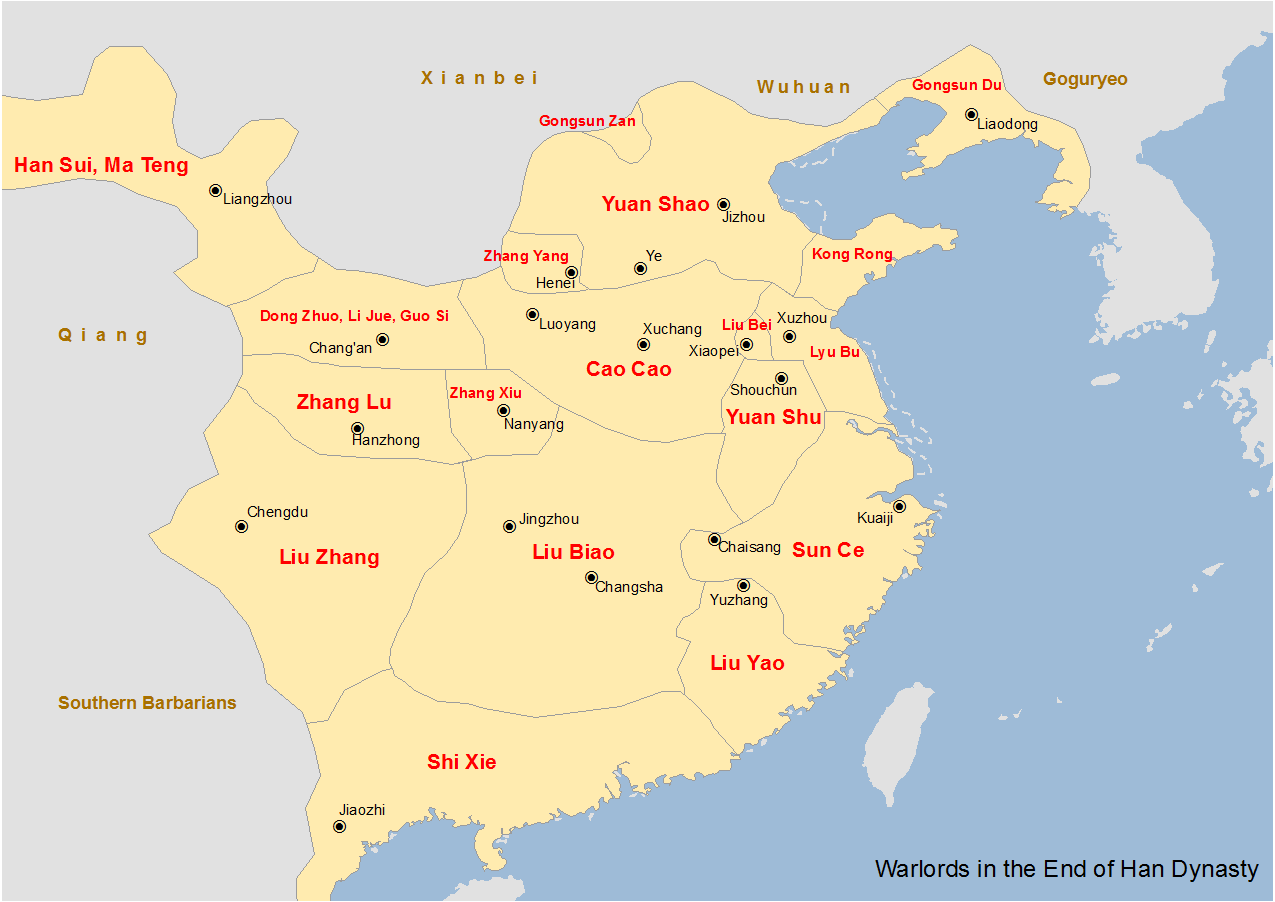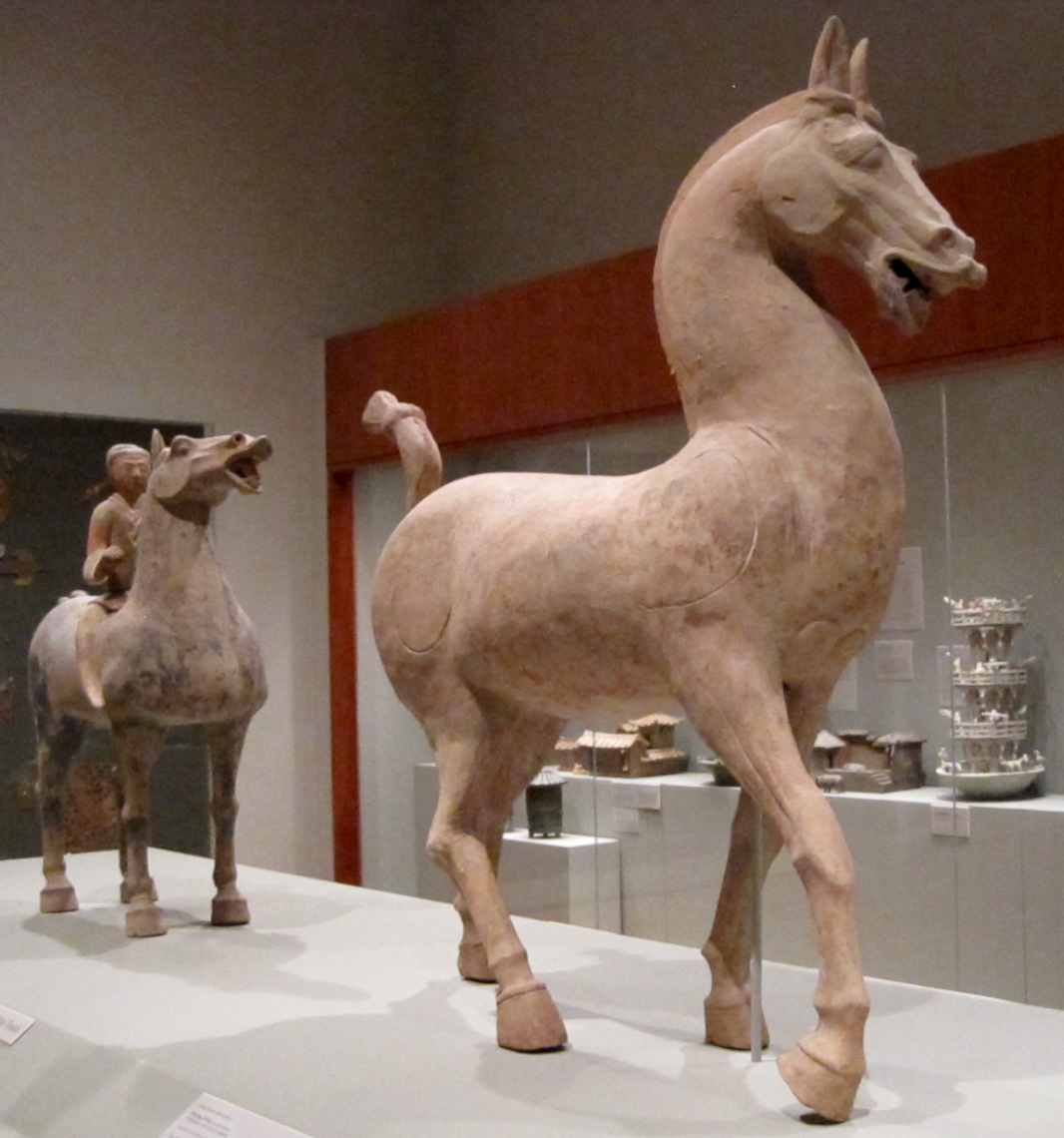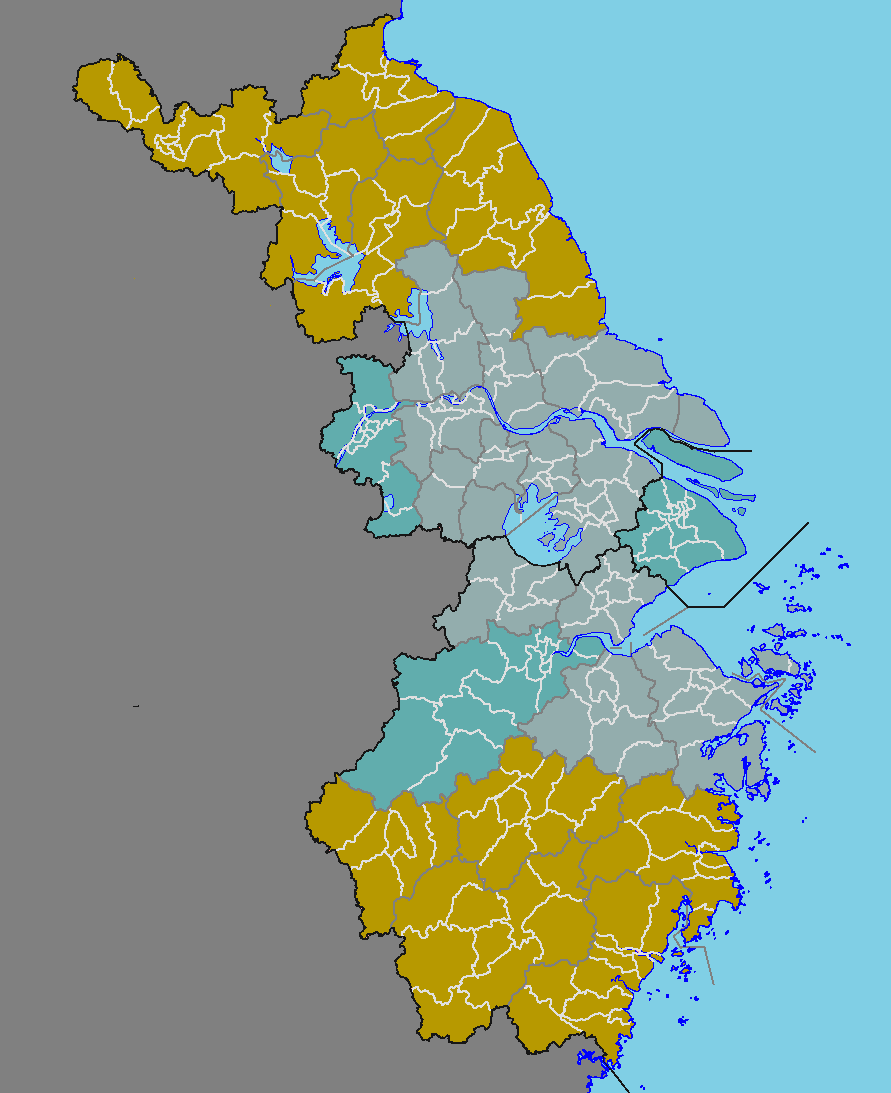|
Cao Xiu
Cao Xiu (died 28 November 228), courtesy name Wenlie, was a Chinese military general of the state of Cao Wei in the Three Kingdoms period of China. A distant younger relative of the warlord Cao Cao, Cao Xiu started his career in the late Eastern Han dynasty as a military officer under Cao Cao. In the early stages of the Hanzhong Campaign of 217–219, he outwitted Zhang Fei and defeated his subordinate officer Wu Lan (吳蘭). Later in his career, he became a provincial-level military commander and fought in various battles against Wei's rival state, Eastern Wu. He died in 228 shortly after the Wei defeat at the Battle of Shiting. Early life Cao Xiu was a distant younger relative of Cao Cao. When the Yellow Turban Rebellion broke out in the late Eastern Han dynasty, the Cao clan left their ancestral home in Qiao County (譙縣; present-day Bozhou, Anhui) and went in different directions throughout the Han Empire to avoid getting caught up in the chaos. When Cao Xiu was around ... [...More Info...] [...Related Items...] OR: [Wikipedia] [Google] [Baidu] |
Cao Rui
Cao Rui () (204 or 205 – 22 January 239), courtesy name Yuanzhong, was the second emperor of the state of Cao Wei during the Three Kingdoms period. His parentage is in dispute: his mother, Lady Zhen, was Yuan Xi's wife, but she later remarried Cao Pi, the first ruler of Wei. Based on conflicting accounts of his age, Pei Songzhi calculated that, in order to be Cao Pi's son, Cao Rui could not have been 36 (by East Asian age reckoning) when he died as recorded, so the recorded age was in error; late-Qing scholars Lu Bi (卢弼) and Mao Guangsheng (冒广生) argued instead that Cao Rui was Yuan Xi's son. Cao Rui's reign was viewed in many different ways throughout Chinese history. He devoted many resources into building palaces and ancestral temples, and his reign saw the stalemate between his empire, Shu Han, and Eastern Wu become more entrenched. His building projects and his desire to have many concubines (who numbered in the thousands) greatly exhausted the imperial trea ... [...More Info...] [...Related Items...] OR: [Wikipedia] [Google] [Baidu] |
Eastern Wu
Wu (Chinese language, Chinese: 吳; pinyin: ''Wú''; Middle Chinese *''ŋuo'' < Eastern Han Chinese: ''*ŋuɑ''), known in historiography as Eastern Wu or Sun Wu, was a Dynasties of China, dynastic state of China and one of the three major states that competed for supremacy over China in the Three Kingdoms period. It previously existed from 220 to 222 as a vassal kingdom nominally under Cao Wei, its rival state, but declared complete independence in November 222. It was elevated to an empire in May 229 after its founding ruler, Sun Quan (Emperor Da), declared himself Emperor of China, emperor. The name "Wu" was derived from the place it was based in—the Jiangnan (Yangtze River Delta) region, which was also historically known as "Wu (region), Wu". It was called "Dong Wu" ("Eastern Wu") or "Sun Wu" by historians to distinguish it from other Chinese historical states with similar names in that region, such as the Wu (state), Wu state in the Spring and Autumn period and the Wuyu ... [...More Info...] [...Related Items...] OR: [Wikipedia] [Google] [Baidu] |
Kaifeng
Kaifeng ( zh, s=开封, p=Kāifēng) is a prefecture-level city in east-Zhongyuan, central Henan province, China. It is one of the Historical capitals of China, Eight Ancient Capitals of China, having been the capital eight times in history, and is most known for having been the Chinese capital during the Song dynasty#Northern Song, 960–1127, Northern Song dynasty. As of the 2020 Chinese census, 2020 census, 4,824,016 people lived in Kaifeng's Prefecture, of whom 1,735,581 lived in the metropolitan area consisting of Xiangfu, Longting, Shunhe Hui, Gulou and Yuwantai Districts. Located along the Yellow River's southern bank, it borders the provincial capital of Zhengzhou to the west, Xinxiang to the northwest, Shangqiu to the east, Zhoukou to the southeast, Xuchang to the southwest, and Heze of Shandong to the northeast. Kaifeng is a major city for scientific research, appearing among the world's top 200 List of cities by scientific output, cities by scientific output as track ... [...More Info...] [...Related Items...] OR: [Wikipedia] [Google] [Baidu] |
Jing Province
Jingzhou or Jing Province was one of the Nine Provinces of ancient China referenced in early Chinese texts such as the ''Yu Gong, Tribute of Yu'', ''Erya'', and ''Rites of Zhou''. Jingzhou became an administrative division during the reign of Emperor Wu of Han, Emperor Wu (r. 141–87 BCE) in the Western Han dynasty (206 BCE–9 CE). It usually corresponded with the modern-day provinces of Hubei and Hunan until the Sui dynasty, after which it referred to the city of Jingzhou. History Pre-Qin era In the Warring States period, the Chu (state), Chu state covered most of present-day Hubei and Hunan, the areas that would form Jingzhou in a later era. The Qin (state), Qin state dropped the name "Chu" (楚) (literally "chaste tree") and used its synonym "Jing" (荊) instead to avoid a naming taboo, since the personal name of Qin's King Zhuangxiang of Qin, King Zhuangxiang (281–247 BCE) was "Zichu" (子楚; lit. "son of Chu") because his adoptive mother, Lady Huayang, was fro ... [...More Info...] [...Related Items...] OR: [Wikipedia] [Google] [Baidu] |
Dong Zhuo
Dong Zhuo () (c. 140s – 22 May 192), courtesy name Zhongying, was a Chinese military general, politician, and warlord who lived in the late Eastern Han dynasty. At the end of the reign of the Eastern Han, Dong Zhuo was a general and powerful minister of the imperial government. Originally from Liang Province, Dong Zhuo seized control of the imperial capital Luoyang in 189 when it entered a state of turmoil following the death of Emperor Ling of Han and a massacre of the eunuch faction by the court officials led by General-in-Chief He Jin. Dong Zhuo subsequently deposed Liu Bian (Emperor Shao) and replaced him with his half-brother, the puppet Emperor Xian to make him become the de facto ruler of China in the boy-emperor's name. The Eastern Han dynasty regime survived in name only. Dong Zhuo's rule was brief and characterized by cruelty and tyranny. In the following year, a coalition of regional officials (; ''cishi'') and warlords launched a campaign against him. Failing ... [...More Info...] [...Related Items...] OR: [Wikipedia] [Google] [Baidu] |
Campaign Against Dong Zhuo
The Campaign against Dong Zhuo was a punitive expedition initiated by a coalition of regional officials and warlords against the warlord Dong Zhuo in 190 in the late Eastern Han dynasty. The members of the coalition claimed that Dong had the intention of usurping the throne by holding Emperor Xian of Han, Emperor Xian hostage and by establishing a strong influence in the imperial court. They justified their campaign as to remove Dong from power. The campaign led to the evacuation of the capital Luoyang and the shifting of the imperial court to Chang'an. It was a prelude to the end of the Han dynasty and, subsequently, the Three Kingdoms period. In the 14th-century historical novel ''Romance of the Three Kingdoms'', the campaign is memorable for at least two famous incidents: one is Guan Yu's slaying of Hua Xiong; the other is the three-on-one duel between the three sworn brothers (Liu Bei, Guan Yu, Zhang Fei) and Lü Bu. The two scenes are often reenacted in Chinese opera along ... [...More Info...] [...Related Items...] OR: [Wikipedia] [Google] [Baidu] |
Jiangsu
Jiangsu is a coastal Provinces of the People's Republic of China, province in East China. It is one of the leading provinces in finance, education, technology, and tourism, with its capital in Nanjing. Jiangsu is the List of Chinese administrative divisions by area, third smallest, but the List of Chinese administrative divisions by population, fifth most populous, with a population of 84.75 million, and the List of Chinese administrative divisions by population density, most densely populated of the 22 provinces of the People's Republic of China. Jiangsu has the highest GDP per capita and second-highest GDP of Chinese provinces, after Guangdong. Jiangsu borders Shandong in the north, Anhui to the west, and Zhejiang and Shanghai to the south. Jiangsu has a coastline of over along the Yellow Sea, and the Yangtze flows through the southern part of the province. Since the Sui dynasty, Sui and Tang dynasty, Tang dynasties, Jiangsu has been a national economic and commercial center ... [...More Info...] [...Related Items...] OR: [Wikipedia] [Google] [Baidu] |
Suzhou, Jiangsu
Suzhou is a major prefecture-level city in southern Jiangsu province, China. As part of the Yangtze Delta megalopolis, it is a major economic center and focal point of trade and commerce. Founded in 514 BC, Suzhou rapidly grew in size by the Eastern Han dynasty, mostly due to emigration from Northern and southern China, northern China. From the 10th century onwards, it has been an important economic, cultural, and commercial center, as well as the largest non-capital city in the world, until it was overtaken by Shanghai. Since Chinese economic reform, economic reforms began in 1978, Suzhou attained GDP growth rates of about 14% in 35 years. In 2023, Suzhou had 5 million registered residents. Suzhou is listed as the 48th List of cities by scientific output, cities by scientific output according to the Nature Index 2022. The city is home to universities, including Soochow University (Suzhou), Soochow University, Suzhou University of Science and Technology, Xi'an Jiaotong–Liverp ... [...More Info...] [...Related Items...] OR: [Wikipedia] [Google] [Baidu] |
Wu Commandery
Wu Commandery was a commandery of imperial China. It covers parts of the contemporary Northern Zhejiang and Southern Jiangsu. The capital of Wu commandery was Wu (today's Suzhou). Major counties of Wu commandery include Wu (county), Yuhang county, and Huating county which later became known as Suzhou, Hangzhou and Shanghai. History During its existence, Wu commandery was ruled by various dynasties and regimes. Chronologically, Han dynasty, Eastern Wu, Jin dynasty, Liu Song dynasty, Southern Qi dynasty, Liang dynasty, Chen dynasty, Sui dynasty and Tang dynasty governed Wu commandery in sequence. In the year of 129, Wu commandery was established during the reign of emperor Shun of Han. When Kuaiji Commandery was divided, lands west of Qiantang river in Kuaiji commandery formed the new Wu commandery. After the division of Kuaiji, Wu constitutes one of the commanderies of Yang Province. In 195, local strongman and warlord of Fuchun count, Sun Ce, acquired the entire Wu command ... [...More Info...] [...Related Items...] OR: [Wikipedia] [Google] [Baidu] |
Yangtze
The Yangtze or Yangzi ( or ) is the longest river in Eurasia and the third-longest in the world. It rises at Jari Hill in the Tanggula Mountains of the Tibetan Plateau and flows including Dam Qu River the longest source of the Yangtze, in a generally easterly direction to the East China Sea. It is the fifth-largest primary river by discharge volume in the world. Its drainage basin comprises one-fifth of the land area of China, and is home to nearly one-third of the country's population. The Yangtze has played a major role in the history, culture, and economy of China. For thousands of years, the river has been used for water, irrigation, sanitation, transportation, industry, boundary-marking, and war. The Yangtze Delta generates as much as 20% of China's GDP, and the Three Gorges Dam on the Yangtze is the largest hydro-electric power station in the world. In mid-2014, the Chinese government announced it was building a multi-tier transport network, comprising railway ... [...More Info...] [...Related Items...] OR: [Wikipedia] [Google] [Baidu] |
Anhui
Anhui is an inland Provinces of China, province located in East China. Its provincial capital and largest city is Hefei. The province is located across the basins of the Yangtze and Huai rivers, bordering Jiangsu and Zhejiang to the east, Jiangxi to the south, Hubei and Henan to the west, and Shandong to the north. With a population of 61 million, Anhui is the 9th most populous province in China. It is the 22nd largest Chinese province based on area, and the 12th most densely populated region of all 34 Chinese provincial regions. Anhui's population is mostly composed of Han Chinese. Languages spoken within the province include Lower Yangtze Mandarin, Wu Chinese, Wu, Huizhou Chinese, Hui, Gan Chinese, Gan and small portion of Central Plains Mandarin. The name "Anhui" derives from the names of two cities: Anqing and Huizhou, Anhui, Huizhou (now Huangshan City). The abbreviation for Anhui is , corresponding to the historical , and is also used to refer to the Wan River and Mount Ti ... [...More Info...] [...Related Items...] OR: [Wikipedia] [Google] [Baidu] |
Bozhou
Bozhou () is a prefecture-level city in northwestern Anhui province, China. It borders Huaibei to the northeast, Bengbu to the southeast, Huainan to the south, Fuyang to the southwest, and Henan to the north. Its population was 4,996,844 at the 2020 census, of whom 1,537,231 lived in the built-up area made of Qiaocheng urban district, even though the county remains largely rural. Administration The prefecture-level city of Bozhou currently administers 4 county-level divisions, including 1 district and 3 counties. * Qiaocheng District () * Guoyang County () * Lixin County () * Mengcheng County () Geography and climate Bozhou features a monsoon-influenced humid subtropical climate (Köppen ''Cwa'') with four distinct seasons. With an annual mean temperature of , the monthly 24-hour average temperature ranges from in January to in August. Winters are damp and cold (yet the precipitation is low) while summers are hot and humid. Rainfall is heavily concentrated in the war ... [...More Info...] [...Related Items...] OR: [Wikipedia] [Google] [Baidu] |









